Understanding the Impact of Street Environments on Traffic Crash Risk from the Perspective of Aging People: An Interpretable Machine Learning Approach
Abstract
1. Introduction
- We examine how street environments influence traffic crashes involving older people, highlighting the greater sensitivity of older people to the street environment.
- We identify specific street environment indicators that impact traffic safety differently for older and non-older people, providing insights for urban planning policies to improve roadway safety for older adults.
- We compare the spatial patterns of street environment contributions across age groups and reveal the age-specific interactions among different indicators.
2. Literature Review
2.1. Built Environment and Traffic Crashes
2.2. Road Safety of Aging Population
3. Study Area and Data
3.1. Study Area
3.2. Data Collection
3.2.1. Traffic Crash Data
3.2.2. Street View Images
3.2.3. Built Environment Data
4. Methods
4.1. Street Environment Measurement
4.2. Training Models of Traffic Crashes
4.3. Interpretable Machine Learning Methods
5. Experimental Results
5.1. Spatial Patterns of Traffic Crashes
5.2. Modeling Traffic Crashes
5.3. Global Interpretability Analysis
5.4. Local Contribution Analysis
5.4.1. Variables with Similar Decreasing Trends
5.4.2. Variables with Similar Increasing Trends
5.4.3. Variables with Different Trends
5.5. Interaction Effect Analysis
6. Discussion and Conclusions
6.1. Effects of Street Environment Indicators
6.2. Interaction Effect Analysis
6.3. Research Contribution
6.4. Policy Implication
6.5. Limitations and Future Work
Author Contributions
Funding
Data Availability Statement
Conflicts of Interest
Appendix A. Factor Information
| Variables | Description | References | |
|---|---|---|---|
| Socio- demographic Factor | Population density | Number of residential population per km2 | [37,93] |
| Gender ratio | The ratio of the number of males per 1000 females | ||
| Proportion of children | The proportion of people who are under 15 years old (%) | ||
| Proportion of elderly | The proportion of people who are aged 65 or above (%) | ||
| Education level | The proportion of people whose highest level of education attended is post-secondary (%) | ||
| Median income | The median of monthly domestic household income (HK$) | ||
| House price | Median monthly domestic household rent (HK$) | ||
| Land Use Factor | Industry | Proportion of industry land use areas | [12,29,37,55,94] |
| Residential | Proportion of residential land use areas | ||
| Commercial | Proportion of commercial land use areas | ||
| Government | Proportion of government land use areas | ||
| Open space | Proportion of open space land use areas | ||
| Land use diversity | Diversity level of land use using Shannon Entropy; C is set of all land use categories, and means density of ith category:
| ||
| Density Factor | Number of intersections | Number of intersections in the hexagonal unit | [57,58] |
| Urban furniture | The average number of street furniture (e.g., traffic light, street light, pole) observed across all street views in the hexagonal unit | ||
| Hospital | Number of hospital POIs in the hexagonal unit | ||
| Shop | Number of shop POIs in the hexagonal unit | ||
| Public | Number of public infrastructure POIs in the hexagonal unit |
| Variables | Description | References |
|---|---|---|
| Water view | The pixel ratio of water view in the SVIs:
| |
| Sky view | The pixel ratio of sky in the SVIs | [32,33,55] |
| Greenness | The visible vegetation in the SVIs captures the green view:
| |
| Enclosure | How the street environment shapes pedestrians’ sense of confinement:
| [20,67] |
| Walkability | How well the street environment supports and encourages walking by being accessible and pedestrian-friendly:
| |
| Crowd attraction | Concentration of people relative to the available road space, indicating how densely populated a street is:
| [20,21] |
| Visual complexity | The variety and richness of elements within street views, captured through Shannon Entropy to quantify diversity:
| [32,43] |
References
- Harwood, R.H. Visual problems and falls. Age Ageing 2001, 30, 13–18. [Google Scholar] [CrossRef] [PubMed]
- Edwards, J.D.; Lister, J.J.; Lin, F.R.; Andel, R.; Brown, L.; Wood, J.M. Association of hearing impairment and subsequent driving mobility in older adults. Gerontologist 2017, 57, 767–775. [Google Scholar] [CrossRef]
- Landi, F.; Liperoti, R.; Russo, A.; Giovannini, S.; Tosato, M.; Capoluongo, E.; Bernabei, R.; Onder, G. Sarcopenia as a risk factor for falls in elderly individuals: Results from the ilSIRENTE study. Clin. Nutr. 2012, 31, 652–658. [Google Scholar] [CrossRef]
- Salthouse, T.A.; Siedlecki, K.L. Efficiency of route selection as a function of adult age. Brain Cogn. 2007, 63, 279–286. [Google Scholar] [CrossRef][Green Version]
- Cicchino, J.B.; McCartt, A.T. Critical older driver errors in a national sample of serious US crashes. Accid. Anal. Prev. 2015, 80, 211–219. [Google Scholar] [CrossRef]
- Ragland, D.R.; Satariano, W.A.; MacLeod, K.E. Reasons given by older people for limitation or avoidance of driving. Gerontologist 2004, 44, 237–244. [Google Scholar] [CrossRef]
- Merlin, L.A.; Guerra, E.; Dumbaugh, E. Crash risk, crash exposure, and the built environment: A conceptual review. Accid. Anal. Prev. 2020, 134, 105244. [Google Scholar] [CrossRef]
- Qiao, S.; Yeh, A.G.O.; Zhang, M.; Yan, X. Effects of state-led suburbanization on traffic crash density in China: Evidence from the Chengdu City Proper. Accid. Anal. Prev. 2020, 148, 105775. [Google Scholar] [CrossRef]
- Guerra, E.; Dong, X.; Kondo, M. Do denser neighborhoods have safer streets? Population density and traffic safety in the Philadelphia region. J. Plan. Educ. Res. 2019, 0739456X19845043. [Google Scholar] [CrossRef]
- Dumbaugh, E.; Rae, R. Safe urban form: Revisiting the relationship between community design and traffic safety. J. Am. Plan. Assoc. 2009, 75, 309–329. [Google Scholar] [CrossRef]
- Yue, H. Investigating the influence of streetscape environmental characteristics on pedestrian crashes at intersections using street view images and explainable machine learning. Accid. Anal. Prev. 2024, 205, 107693. [Google Scholar] [CrossRef] [PubMed]
- Chen, P.; Sun, F.; Wang, Z.; Gao, X.; Jiao, J.; Tao, Z. Built environment effects on bike crash frequency and risk in Beijing. J. Saf. Res. 2018, 64, 135–143. [Google Scholar] [CrossRef]
- Miranda-Moreno, L.F.; Morency, P.; El-Geneidy, A.M. The link between built environment, pedestrian activity and pedestrian–vehicle collision occurrence at signalized intersections. Accid. Anal. Prev. 2011, 43, 1624–1634. [Google Scholar] [CrossRef] [PubMed]
- Salesses, P.; Schechtner, K.; Hidalgo, C.A. The collaborative image of the city: Mapping the inequality of urban perception. PLoS ONE 2013, 8, e68400. [Google Scholar] [CrossRef] [PubMed]
- Fan, Z.; Zhang, F.; Loo, B.P.; Ratti, C. Urban visual intelligence: Uncovering hidden city profiles with street view images. Proc. Natl. Acad. Sci. USA 2023, 120, e2220417120. [Google Scholar] [CrossRef]
- Wang, R.; Yuan, Y.; Liu, Y.; Zhang, J.; Liu, P.; Lu, Y.; Yao, Y. Using street view data and machine learning to assess how perception of neighborhood safety influences urban residents’ mental health. Health Place 2019, 59, 102186. [Google Scholar] [CrossRef]
- Zhang, T.; Huang, B.; Yan, Y.; Lin, Y.; Wong, H.; Wong, S.Y.s.; Chung, R.Y.N. Associations of residential greenness with unhealthy consumption behaviors: Evidence from high-density Hong Kong using street-view and conventional exposure metrics. Int. J. Hyg. Environ. Health 2023, 249, 114145. [Google Scholar] [CrossRef]
- Wu, C.; Du, Y.; Li, S.; Liu, P.; Ye, X. Does visual contact with green space impact housing prices? An integrated approach of machine learning and hedonic modeling based on the perception of green space. Land Use Policy 2022, 115, 106048. [Google Scholar] [CrossRef]
- Zhou, Y.; Thill, J.C.; Liu, X.; Zhong, C.; Tu, W. Measuring and understanding changes in the physical built environment of cities with street view images. Urban Informatics 2025, 4, 3. [Google Scholar] [CrossRef]
- Rui, J. Exploring the association between the settlement environment and residents’ positive sentiments in urban villages and formal settlements in Shenzhen. Sustain. Cities Soc. 2023, 98, 104851. [Google Scholar] [CrossRef]
- Ma, S.; Wang, B.; Liu, W.; Zhou, H.; Wang, Y.; Li, S. Assessment of street space quality and subjective well-being mismatch and its impact, using multi-source big data. Cities 2024, 147, 104797. [Google Scholar] [CrossRef]
- Almadi, A.I.; Al Mamlook, R.E.; Almarhabi, Y.; Ullah, I.; Jamal, A.; Bandara, N. A fuzzy-logic approach based on driver decision-making behavior modeling and simulation. Sustainability 2022, 14, 8874. [Google Scholar] [CrossRef]
- Deniz, P.; Lajunen, T.; Özkan, T.; Gaygısız, E. Masculinity, femininity, and angry drivers: Masculinity and femininity as moderators between driver anger and anger expression style among young drivers. Accid. Anal. Prev. 2021, 161, 106347. [Google Scholar] [CrossRef] [PubMed]
- Singh, H.; Kathuria, A. Analyzing driver behavior under naturalistic driving conditions: A review. Accid. Anal. Prev. 2021, 150, 105908. [Google Scholar] [CrossRef] [PubMed]
- Guo, M.; Zhao, X.; Yao, Y.; Yan, P.; Su, Y.; Bi, C.; Wu, D. A study of freeway crash risk prediction and interpretation based on risky driving behavior and traffic flow data. Accid. Anal. Prev. 2021, 160, 106328. [Google Scholar] [CrossRef]
- Ewing, R.; Dumbaugh, E. The built environment and traffic safety: A review of empirical evidence. J. Plan. Lit. 2009, 23, 347–367. [Google Scholar] [CrossRef]
- Cespedes, L.; Ayuso, M.; Santolino, M. Effect of population density in aging societies and severity of motor vehicle crash injuries: The case of Spain. Eur. Transp. Res. Rev. 2024, 16, 48. [Google Scholar] [CrossRef]
- Wang, S.; Gao, K.; Zhang, L.; Yu, B.; Easa, S.M. Geographically weighted machine learning for modeling spatial heterogeneity in traffic crash frequency and determinants in US. Accid. Anal. Prev. 2024, 199, 107528. [Google Scholar] [CrossRef]
- Ding, H.; Sze, N.; Li, H.; Guo, Y. Roles of infrastructure and land use in bicycle crash exposure and frequency: A case study using Greater London bike sharing data. Accid. Anal. Prev. 2020, 144, 105652. [Google Scholar] [CrossRef]
- Weich, S.; Burton, E.; Blanchard, M.; Prince, M.; Sproston, K.; Erens, B. Measuring the built environment: Validity of a site survey instrument for use in urban settings. Health Place 2001, 7, 283–292. [Google Scholar] [CrossRef]
- Boarnet, M.G.; Forsyth, A.; Day, K.; Oakes, J.M. The street level built environment and physical activity and walking: Results of a predictive validity study for the Irvine Minnesota Inventory. Environ. Behav. 2011, 43, 735–775. [Google Scholar] [CrossRef]
- Cai, Q.; Abdel-Aty, M.; Zheng, O.; Wu, Y. Applying machine learning and google street view to explore effects of drivers’ visual environment on traffic safety. Transp. Res. Part C Emerg. Technol. 2022, 135, 103541. [Google Scholar] [CrossRef]
- Ye, Y.; He, J.; Hu, J.; Sun, S.; Zhang, C.; Yan, X.; Wang, C.; Qin, P. Exploring the effect of driving environment on driver stress: A framework based on urban street view and explainable machine learning. J. Intell. Transp. Syst. 2025, 1–17. [Google Scholar] [CrossRef]
- Hamim, O.F.; Ukkusuri, S.V. Towards safer streets: A framework for unveiling pedestrians’ perceived road safety using street view imagery. Accid. Anal. Prev. 2024, 195, 107400. [Google Scholar] [CrossRef]
- Howlader, M.M.; Mannering, F.; Haque, M.M. Estimating crash risk and injury severity considering multiple traffic conflict and crash types: A bivariate extreme value approach. Anal. Methods Accid. Res. 2024, 42, 100331. [Google Scholar] [CrossRef]
- Lee, S.; Yoon, J.; Woo, A. Does elderly safety matter? Associations between built environments and pedestrian crashes in Seoul, Korea. Accid. Anal. Prev. 2020, 144, 105621. [Google Scholar] [CrossRef]
- Lee, J.; Gim, T.H.T. Analysing the injury severity characteristics of urban elderly drivers’ traffic accidents through the generalised ordered logit model: A case of Seoul, South Korea. J. Transp. Saf. Secur. 2022, 14, 1139–1164. [Google Scholar] [CrossRef]
- Lijarcio, I.; Useche, S.A.; Llamazares, J.; Montoro, L. Are your eyes “on the road”? Findings from the 2019 national study on vision and driving safety in Spain. Int. J. Environ. Res. Public Health 2020, 17, 3195. [Google Scholar] [CrossRef]
- Dunbar, G.; Holland, C.A.; Maylor, E.A. Older Pedestrians: A Critical Review of the Literature; Road Safety Research Report; The Department for Transport: London, UK, 2004. [Google Scholar]
- Norman, J.F.; Ramirez, A.B.; Bryant, E.N.; Adcock, P.; Parekh, H.; Brase, A.M.; Peterson, R.D. Aging and the visual perception of rigid and nonrigid motion. Sci. Rep. 2024, 14, 27657. [Google Scholar] [CrossRef]
- Paraskevoudi, N.; Balcı, F.; Vatakis, A. “Walking” through the sensory, cognitive, and temporal degradations of healthy aging. Ann. N. Y. Acad. Sci. 2018, 1426, 72–92. [Google Scholar] [CrossRef]
- Pham, L.A.T.; Nguyen, B.T.; Huynh, D.T.; Nguyen, B.M.L.T.; Tran, P.A.N.; Van Vo, T.; Bui, H.H.T.; Thai, T.T. Community-based prevalence and associated factors of sarcopenia in the Vietnamese elderly. Sci. Rep. 2024, 14, 17. [Google Scholar] [CrossRef] [PubMed]
- Biernacki, M.P.; Lewkowicz, R. How do older drivers perceive visual information under increasing cognitive load? Significance of personality on-road safety. Accid. Anal. Prev. 2021, 157, 106186. [Google Scholar] [CrossRef]
- Molnar, L.J.; Eby, D.W.; Charlton, J.L.; Langford, J.; Koppel, S.; Marshall, S.; Man-Son-Hing, M. Reprint of “Driving avoidance by older adults: Is it always self-regulation?”. Accid. Anal. Prev. 2013, 61, 272–280. [Google Scholar] [CrossRef]
- Kim, S.; Choi, S.; Kim, B.H. Analysis of factors affecting pedestrian safety for the elderly and identification of vulnerable areas in Seoul. Accid. Anal. Prev. 2025, 211, 107878. [Google Scholar] [CrossRef]
- Wilmut, K.; Purcell, C. Why are older adults more at risk as pedestrians? A systematic review. Hum. Factors 2022, 64, 1269–1291. [Google Scholar] [CrossRef]
- Dommes, A.; Cavallo, V.; Dubuisson, J.B.; Tournier, I.; Vienne, F. Crossing a two-way street: Comparison of young and old pedestrians. J. Saf. Res. 2014, 50, 27–34. [Google Scholar] [CrossRef]
- Ekstrom, A.D.; Hill, P.F. Spatial navigation and memory: A review of the similarities and differences relevant to brain models and age. Neuron 2023, 111, 1037–1049. [Google Scholar] [CrossRef]
- C &S Department. Hong Kong Population Projections for 2022 to 2046. Hong Kong: Census and Statistics Department. 2023. Available online: https://www.censtatd.gov.hk/en/EIndexbySubject.html?pcode=B1120015&scode=190 (accessed on 9 May 2025).
- Liu, J.; Meng, B.; Shi, C. A multi-activity view of intra-urban travel networks: A case study of Beijing. Cities 2023, 143, 104634. [Google Scholar] [CrossRef]
- Lian, T.; Loo, B.P. Cost of travel delays caused by traffic crashes. Commun. Transp. Res. 2024, 4, 100124. [Google Scholar] [CrossRef]
- Su, J.; Sze, N. Safety of walking trips accessing to public transportation: A Bayesian spatial model in Hong Kong. Travel Behav. Soc. 2022, 29, 125–135. [Google Scholar] [CrossRef]
- Hu, S.; Xing, H.; Luo, W.; Wu, L.; Xu, Y.; Huang, W.; Liu, W.; Li, T. Uncovering the association between traffic crashes and street-level built-environment features using street view images. Int. J. Geogr. Inf. Sci. 2023, 37, 2367–2391. [Google Scholar] [CrossRef]
- Liu, J.; Shen, K.; Liu, X.; Wu, C. Unravelling the multiple effects of multilevel neighborhood characteristics on traffic crash risk from a spatiotemporal heterogeneity perspective. Travel Behav. Soc. 2025, 40, 101044. [Google Scholar] [CrossRef]
- Yue, H. Investigating streetscape environmental characteristics associated with road traffic crashes using street view imagery and computer vision. Accid. Anal. Prev. 2025, 210, 107851. [Google Scholar] [CrossRef] [PubMed]
- Planning Department. Land Utilization in Hong Kong. 2023. Available online: https://www.pland.gov.hk/pland_en/info_serv/open_data/landu/ (accessed on 2 April 2025).
- Jia, R.; Khadka, A.; Kim, I. Traffic crash analysis with point-of-interest spatial clustering. Accid. Anal. Prev. 2018, 121, 223–230. [Google Scholar] [CrossRef]
- Chen, H.; Chen, H.; Liu, Z.; Sun, X.; Zhou, R. Analysis of factors affecting the severity of automated vehicle crashes using XGBoost model combining POI data. J. Adv. Transp. 2020, 2020, 8881545. [Google Scholar] [CrossRef]
- C & S Department. 2021 Population Census. 2021. Available online: https://www.census2021.gov.hk/en/district_profiles.html (accessed on 2 April 2025).
- Stoker, P.; Garfinkel-Castro, A.; Khayesi, M.; Odero, W.; Mwangi, M.N.; Peden, M.; Ewing, R. Pedestrian safety and the built environment: A review of the risk factors. J. Plan. Lit. 2015, 30, 377–392. [Google Scholar] [CrossRef]
- Halaweh, H.; Dahlin-Ivanoff, S.; Svantesson, U.; Willén, C. Perspectives of older adults on aging well: A focus group study. J. Aging Res. 2018, 2018, 9858252. [Google Scholar] [CrossRef]
- Wang, Z.; Yang, H.; Guo, Z.; Liu, B.; Geng, S. Socio-demographic characteristics and co-occurrence of depressive symptoms with chronic diseases among older adults in China: The China longitudinal ageing social survey. BMC Psychiatry 2019, 19, 310. [Google Scholar] [CrossRef]
- Bergeron, E.; Rossignol, M.; Osler, T.; Clas, D. Improving the TRISS methodology by restructuring age categories and adding comorbidities. J. Trauma Acute Care Surg. 2004, 56, 760–767. [Google Scholar] [CrossRef]
- Caterino, J.M.; Valasek, T.; Werman, H.A. Identification of an age cutoff for increased mortality in patients with elderly trauma. Am. J. Emerg. Med. 2010, 28, 151–158. [Google Scholar] [CrossRef]
- Zhao, H.; Shi, J.; Qi, X.; Wang, X.; Jia, J. Pyramid scene parsing network. In Proceedings of the IEEE Conference on Computer Vision and Pattern Recognition, Honolulu, HI, USA, 21–26 July 2017; pp. 2881–2890. [Google Scholar]
- Zhou, B.; Zhao, H.; Puig, X.; Fidler, S.; Barriuso, A.; Torralba, A. Scene parsing through ade20k dataset. In Proceedings of the IEEE Conference on Computer Vision and Pattern Recognition, Honolulu, HI, USA, 21–26 July 2017; pp. 633–641. [Google Scholar]
- He, J.; Zhang, J.; Yao, Y.; Li, X. Extracting human perceptions from street view images for better assessing urban renewal potential. Cities 2023, 134, 104189. [Google Scholar] [CrossRef]
- Breiman, L. Random forests. Mach. Learn. 2001, 45, 5–32. [Google Scholar] [CrossRef]
- Dai, J.; Tian, X.; Liu, L.; Zhang, H.; Fu, J.; Yu, M. The Intelligent Traffic Safety System Based on 6G Technology and Random Forest Algorithm. IEEE Trans. Intell. Transp. Syst. 2025. [Google Scholar] [CrossRef]
- Zhou, X.; Lu, P.; Zheng, Z.; Tolliver, D.; Keramati, A. Accident prediction accuracy assessment for highway-rail grade crossings using random forest algorithm compared with decision tree. Reliab. Eng. Syst. Saf. 2020, 200, 106931. [Google Scholar] [CrossRef]
- Lundberg, S.M.; Lee, S.I. A unified approach to interpreting model predictions. In Proceedings of the 31st Conference on Neural Information Processing Systems (NeurIPS 2017), Long Beach, CA, USA, 4–9 December 2017. [Google Scholar]
- Friedman, J.H. Greedy function approximation: A gradient boosting machine. Ann. Stat. 2001, 29, 1189–1232. [Google Scholar] [CrossRef]
- Szeto, W.; Yang, L.; Wong, R.; Li, Y.; Wong, S. Spatio-temporal travel characteristics of the elderly in an ageing society. Travel Behav. Soc. 2017, 9, 10–20. [Google Scholar] [CrossRef]
- Haustein, S.; Siren, A. Older people’s mobility: Segments, factors, trends. Transp. Rev. 2015, 35, 466–487. [Google Scholar] [CrossRef]
- Rahman, M.; Kockelman, K.M.; Perrine, K.A. Investigating risk factors associated with pedestrian crash occurrence and injury severity in Texas. Traffic Inj. Prev. 2022, 23, 283–289. [Google Scholar] [CrossRef]
- Tamakloe, R.; Zhang, K.; Kim, I. Temporal instability of the determinants of fatal/severe elderly pedestrian injury outcomes in intersections and non-intersections before, during, and after the COVID-19 pandemic. Accid. Anal. Prev. 2024, 205, 107676. [Google Scholar] [CrossRef]
- Peel, T.; Ahmed, M.; Ohara, N. Investigating safety effectiveness of Wyoming snow fence installations along a rural mountainous freeway. Transp. Res. Rec. 2017, 2613, 8–15. [Google Scholar] [CrossRef]
- PE, W.E.M.; Coppola, N.; Golombek, Y. Urban clear zones, street trees, and road safety. Res. Transp. Bus. Manag. 2018, 29, 136–143. [Google Scholar]
- Zhang, X.; Zhao, X.; Bian, Y.; Huang, J.; Yin, L. Interactive effects analysis of road, traffic, and weather characteristics on shared e-bike speeding risk: A data-driven approach. Accid. Anal. Prev. 2024, 207, 107755. [Google Scholar] [CrossRef] [PubMed]
- Lee, J.S.; Zegras, P.C.; Ben-Joseph, E. Safely active mobility for urban baby boomers: The role of neighborhood design. Accid. Anal. Prev. 2013, 61, 153–166. [Google Scholar] [CrossRef]
- Dommes, A.; Le Lay, T.; Vienne, F.; Dang, N.T.; Beaudoin, A.P.; Do, M.C. Towards an explanation of age-related difficulties in crossing a two-way street. Accid. Anal. Prev. 2015, 85, 229–238. [Google Scholar] [CrossRef]
- Zhang, K.; Tamakloe, R.; Cao, M.; Kim, I. Exploring fatal/severe pedestrian injury crash frequency at school zone crash hotspots: Using interpretable machine learning to assess the micro-level street environment. J. Transp. Geogr. 2024, 121, 104034. [Google Scholar] [CrossRef]
- Wang, R.; Lu, Y.; Zhang, J.; Liu, P.; Yao, Y.; Liu, Y. The relationship between visual enclosure for neighbourhood street walkability and elders’ mental health in China: Using street view images. J. Transp. Health 2019, 13, 90–102. [Google Scholar] [CrossRef]
- Barnett, D.W.; Barnett, A.; Nathan, A.; Van Cauwenberg, J.; Cerin, E.; on behalf of the Council on Environment and Physical Activity (CEPA)—Older Adults Working Group. Built environmental correlates of older adults’ total physical activity and walking: A systematic review and meta-analysis. Int. J. Behav. Nutr. Phys. Act. 2017, 14, 1–24. [Google Scholar] [CrossRef]
- Duim, E.; Lebrão, M.L.; Antunes, J.L.F. Walking speed of older people and pedestrian crossing time. J. Transp. Health 2017, 5, 70–76. [Google Scholar] [CrossRef]
- Theofilatos, A.; Ziakopoulos, A.; Oviedo-Trespalacios, O.; Timmis, A. To cross or not to cross? Review and meta-analysis of pedestrian gap acceptance decisions at midblock street crossings. J. Transp. Health 2021, 22, 101108. [Google Scholar] [CrossRef]
- Chong, S.; Mazumdar, S.; Jalaludin, B.; Hatfield, J. Associations between Walkability and pedestrian related injuries is modified by Sociodemographic characteristics. Injury 2022, 53, 3978–3986. [Google Scholar] [CrossRef]
- Rockhill, S.M.; Soto, G.W.; Whitfield, G.P.; Barry, V.; Fletcher, K. Associations between National walkability Index and Traffic-Related pedestrian Deaths, United States, 2017–2019. Transp. Res. Interdiscip. Perspect. 2025, 31, 101404. [Google Scholar] [CrossRef]
- Chiang, Y.C.; Ke, R.A.; Li, D.; Weng, P.Y. Greening and safety: The influence of road greenness on driver’s attention and emergency reaction time. Environ. Behav. 2022, 54, 1195–1226. [Google Scholar] [CrossRef]
- Lee, S.C.; Kim, Y.W.; Ji, Y.G. Effects of visual complexity of in-vehicle information display: Age-related differences in visual search task in the driving context. Appl. Ergon. 2019, 81, 102888. [Google Scholar] [CrossRef] [PubMed]
- Gálvez-Pérez, D.; Guirao, B.; Ortuño, A. Age-Friendly Urban Design for Older Pedestrian Road Safety: A Street Segment Level Analysis in Madrid. Sustainability 2024, 16, 8298. [Google Scholar] [CrossRef]
- Jurado Martins de Oliveira, G.; Lavieri, P.S.; Cunha, A.L. Integrating a non-gridded space representation into a graph neural networks model for citywide short-term crash risk prediction. Urban Inform. 2023, 2, 7. [Google Scholar] [CrossRef]
- Yu, C.Y.; Xu, M. Local variations in the impacts of built environments on traffic safety. J. Plan. Educ. Res. 2018, 38, 314–328. [Google Scholar] [CrossRef]
- Chen, P.; Zhou, J. Effects of the built environment on automobile-involved pedestrian crash frequency and risk. J. Transp. Health 2016, 3, 448–456. [Google Scholar] [CrossRef]
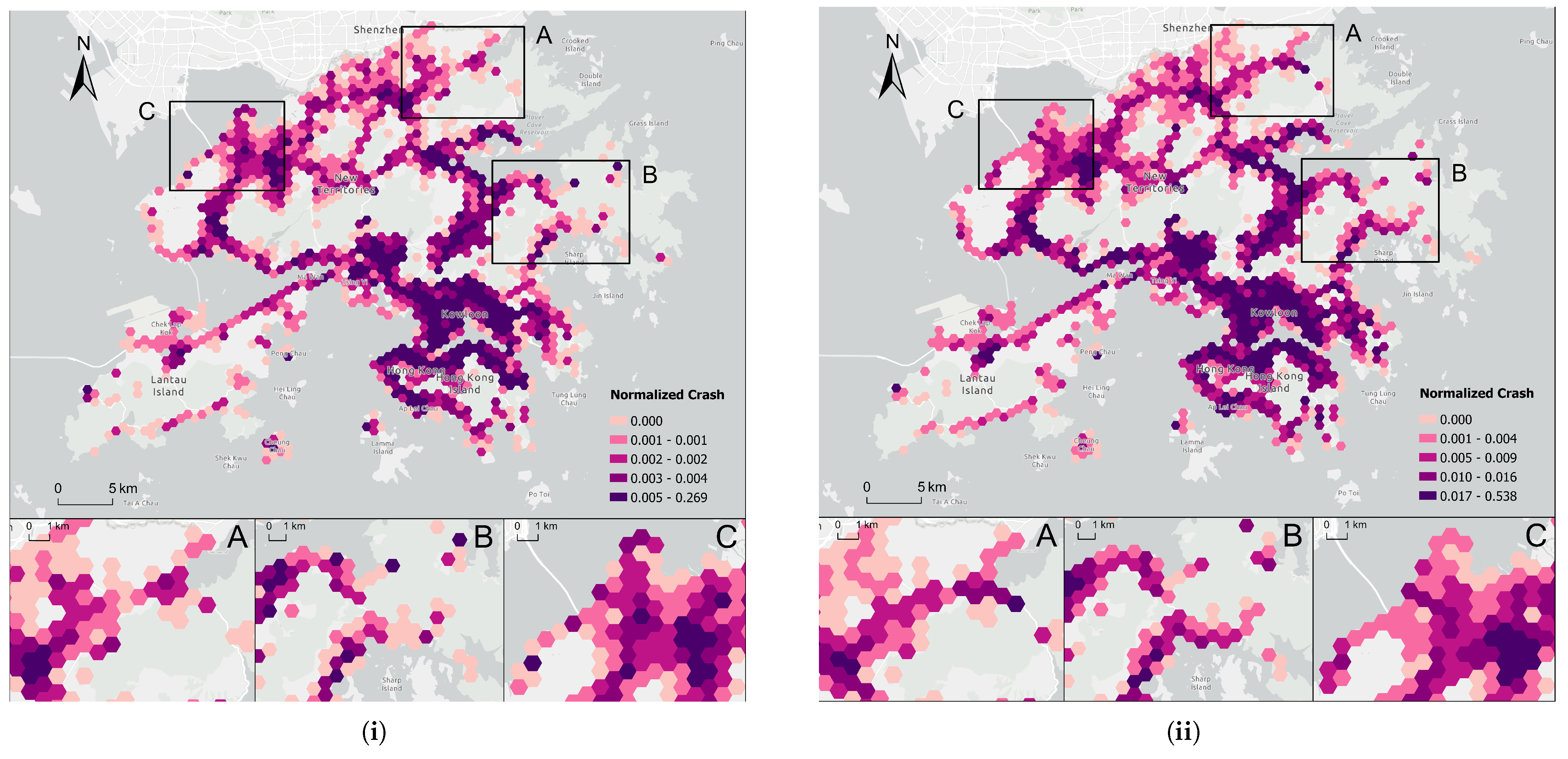
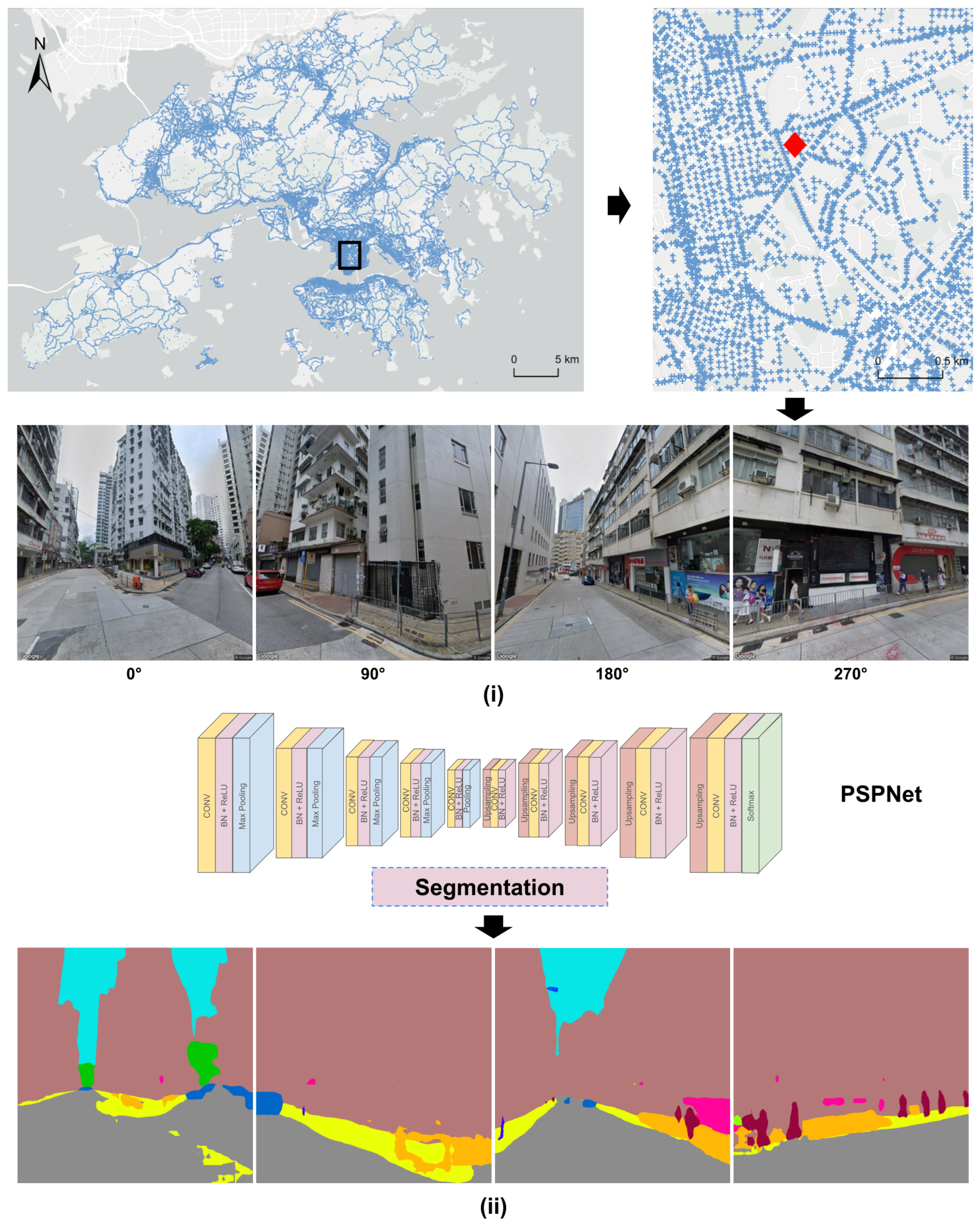



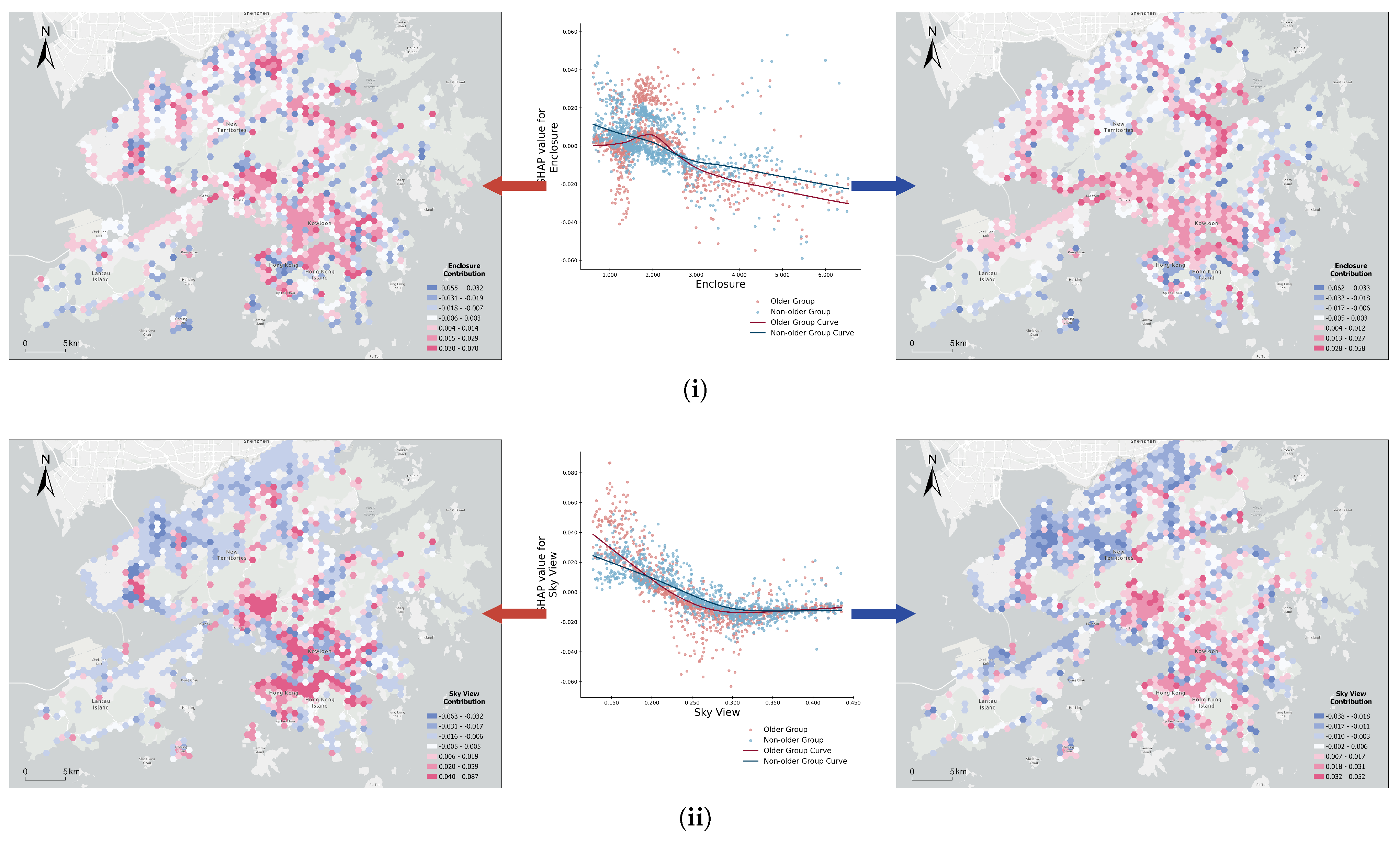
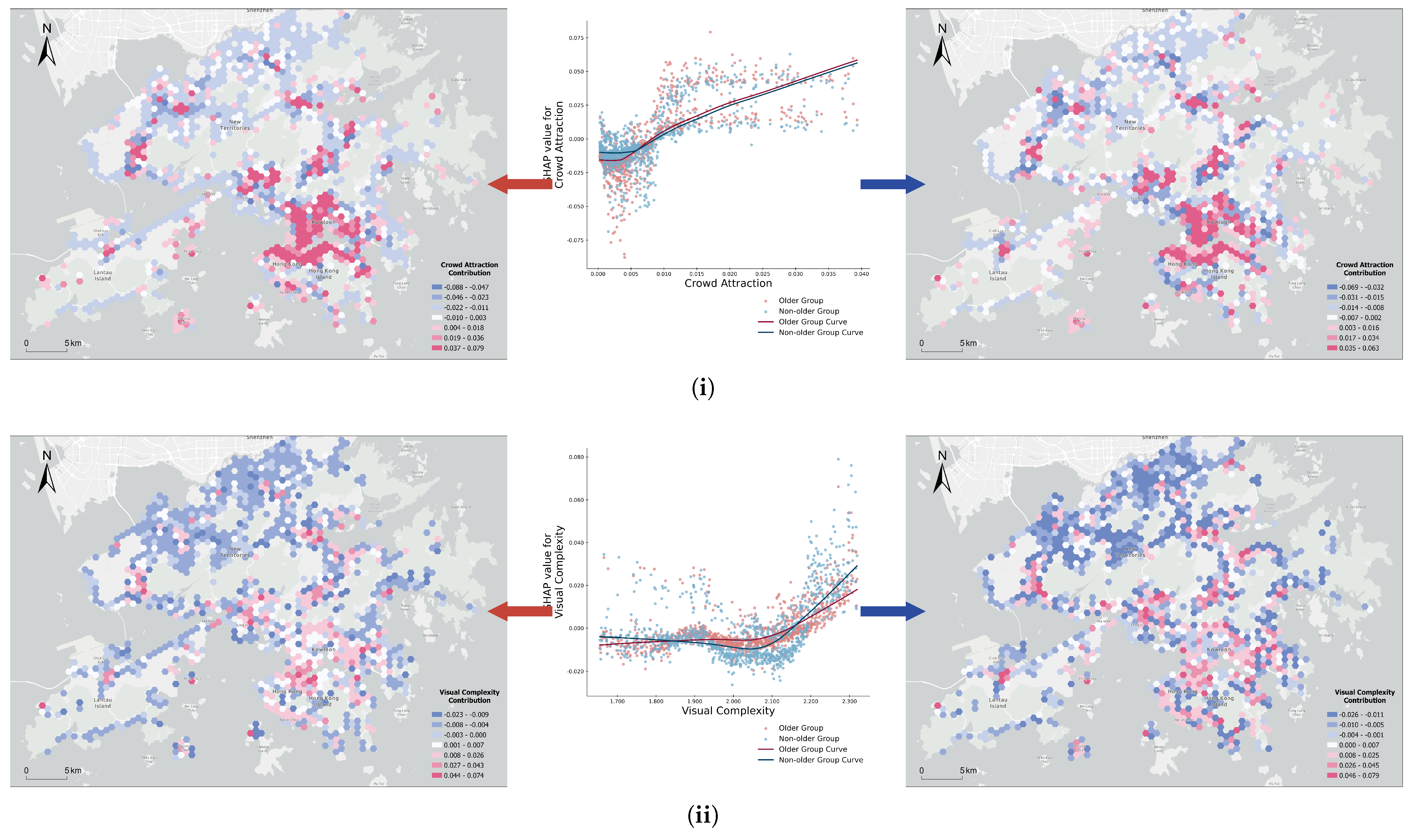
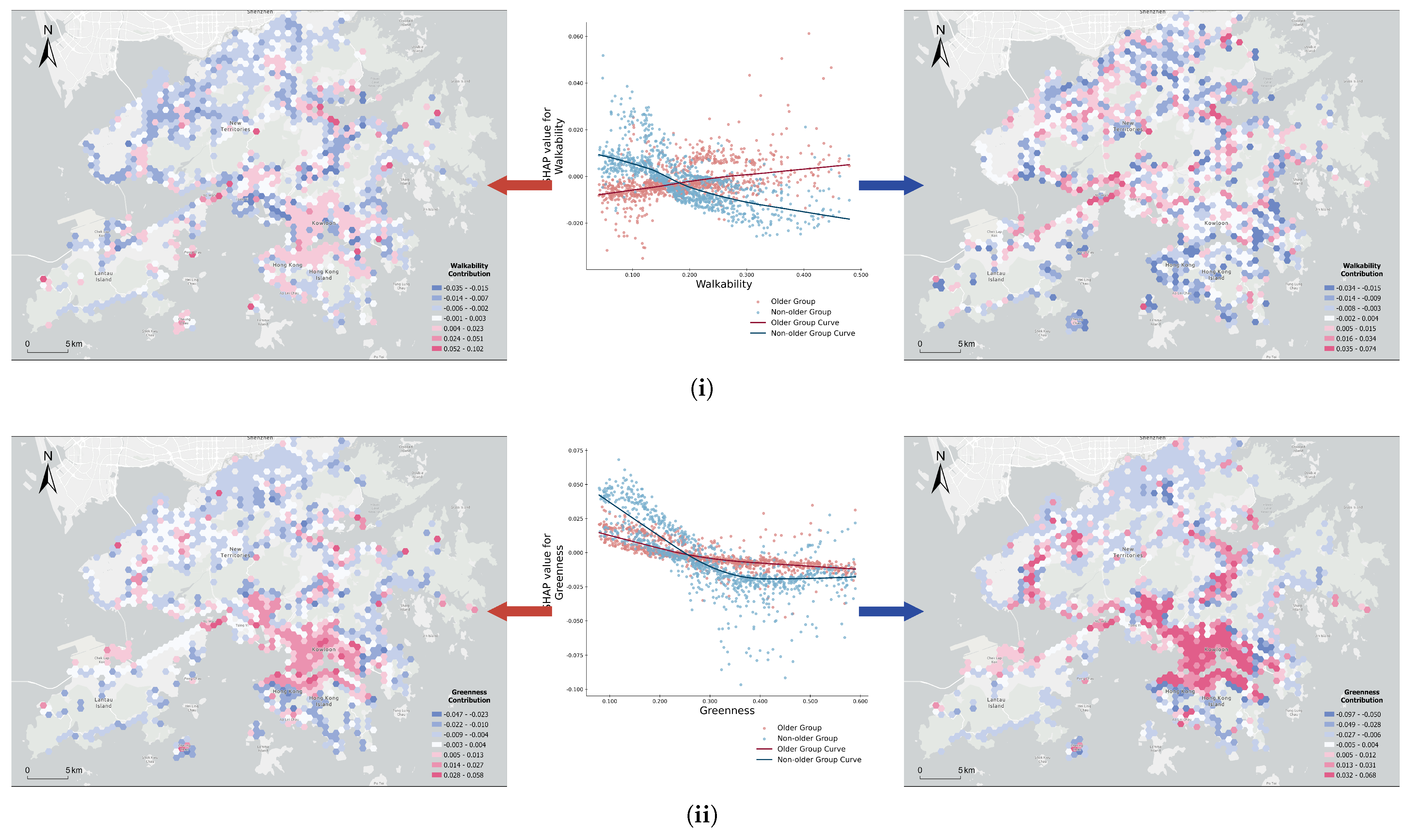
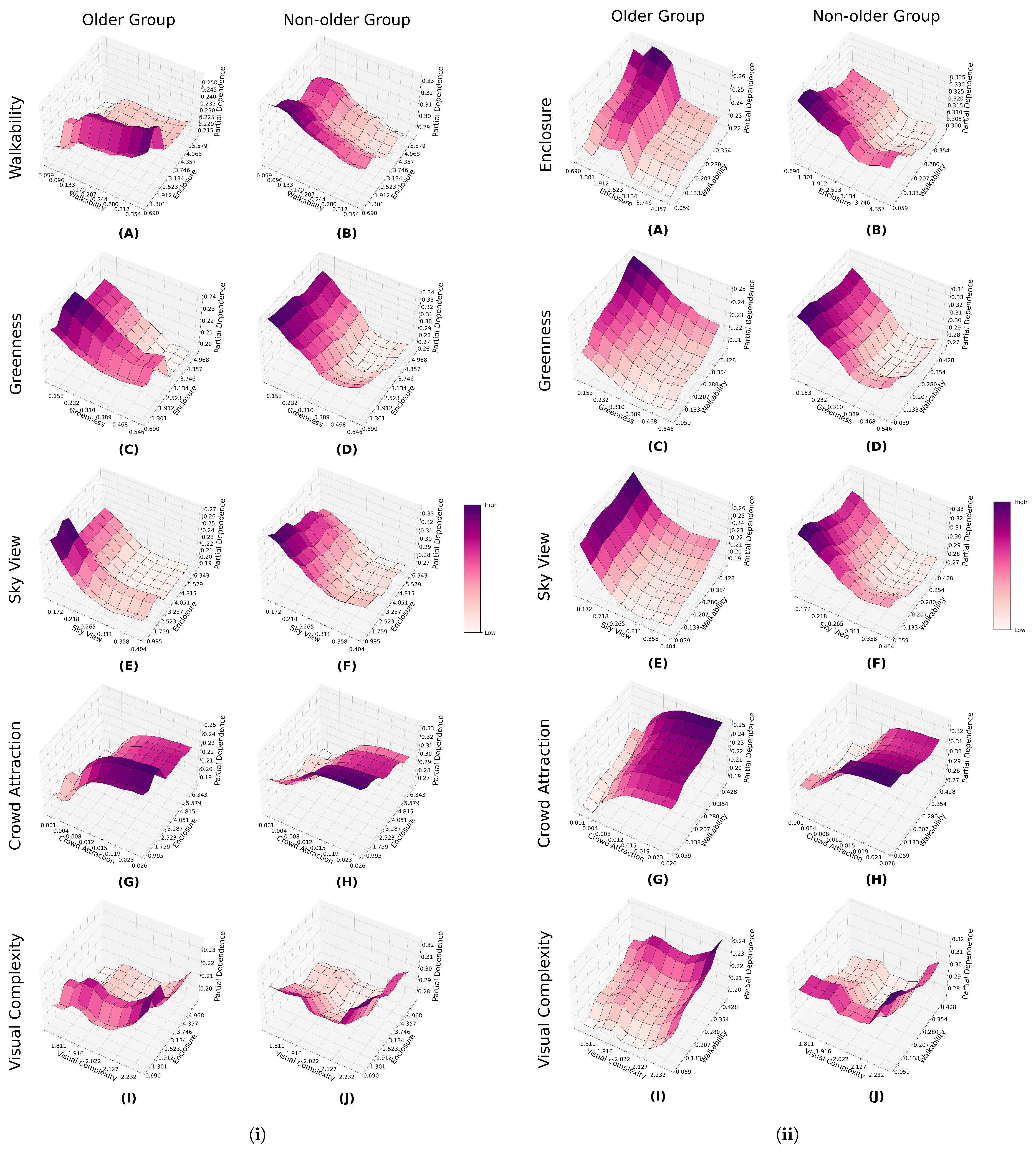
| Variable | Group | Trend | Threshold | Important Areas |
|---|---|---|---|---|
| Enclosure | Older | ↘ | 0.0; 2.5 | Yau Tsim Mong District and Kwai Tsing District |
| Non-older | ↘ | 2.0 | Boundary of natural parks | |
| Sky View | Older | ↘ | 0.22 | Kowloon City District and Northern Hong Kong Island |
| Non-older | ↘ | 0.25 | – | |
| Crowd Attraction | Older | ↗ | 0.07 | Kowloon Area and Northern Hong Kong Island |
| Non-older | ↗ | 0.07 | Kowloon Area and Northern Hong Kong Island | |
| Visual Complexity | Older | 2.15 | – | |
| Non-older | 2.15 | Kwai Tsing District | ||
| Walkability | Older | ↗ | 0.25 | Kowloon Area and Northern Hong Kong Island |
| Non-older | ↘ | 0.15 | – | |
| Greenness | Older | ↘ | 0.28 | – |
| Non-older | 0.28 | – |
Disclaimer/Publisher’s Note: The statements, opinions and data contained in all publications are solely those of the individual author(s) and contributor(s) and not of MDPI and/or the editor(s). MDPI and/or the editor(s) disclaim responsibility for any injury to people or property resulting from any ideas, methods, instructions or products referred to in the content. |
© 2025 by the authors. Published by MDPI on behalf of the International Society for Photogrammetry and Remote Sensing. Licensee MDPI, Basel, Switzerland. This article is an open access article distributed under the terms and conditions of the Creative Commons Attribution (CC BY) license (https://creativecommons.org/licenses/by/4.0/).
Share and Cite
Shen, K.; Liu, J.; Liu, X. Understanding the Impact of Street Environments on Traffic Crash Risk from the Perspective of Aging People: An Interpretable Machine Learning Approach. ISPRS Int. J. Geo-Inf. 2025, 14, 248. https://doi.org/10.3390/ijgi14070248
Shen K, Liu J, Liu X. Understanding the Impact of Street Environments on Traffic Crash Risk from the Perspective of Aging People: An Interpretable Machine Learning Approach. ISPRS International Journal of Geo-Information. 2025; 14(7):248. https://doi.org/10.3390/ijgi14070248
Chicago/Turabian StyleShen, Ketong, Jian Liu, and Xintao Liu. 2025. "Understanding the Impact of Street Environments on Traffic Crash Risk from the Perspective of Aging People: An Interpretable Machine Learning Approach" ISPRS International Journal of Geo-Information 14, no. 7: 248. https://doi.org/10.3390/ijgi14070248
APA StyleShen, K., Liu, J., & Liu, X. (2025). Understanding the Impact of Street Environments on Traffic Crash Risk from the Perspective of Aging People: An Interpretable Machine Learning Approach. ISPRS International Journal of Geo-Information, 14(7), 248. https://doi.org/10.3390/ijgi14070248







